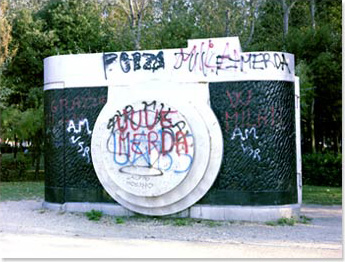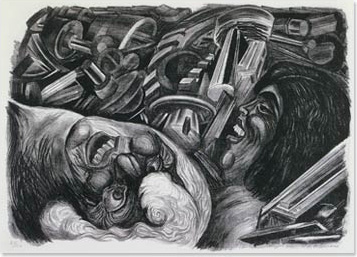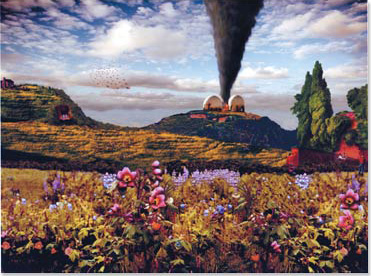Since the seventeenth century, the most common understanding of the universe was based on the work of French mathematician and philosopher René Descartes (French philosopher and mathematician, 1596-1650). The Cartesian coordinate system postulated that the universe was regular and finite, and that space and time could be measured independently of each other. At the turn of the twentieth century, Albert Einstein(German-born theoretical physicist, 1879-1955) proposed that time and space are relative to the observer—they stretch and change—and are, in fact, two sides of the same coin. One cannot be considered separate from the other. Einstein's realization they they were linked, that they formed what he called the space-time continuum is the most remarkable metaphor of the twentieth century. Our experiences of space and time are so intertwined that we cannot understand one without the other: They are fundamental units of exchange in the ongoing intercourse of society. Creativity is, in part the management of the abstract dimensions that constantly embrace us.
History can be seen as the struggle to define our relationship to the world through time and space. We can see evidence of this struggle in the placement of tools, food, and other artifacts in prehistoric burial sites. Anthropologists believe that this indicates some belief in an afterlife, as the dead were prepared for their journey through the future. Paintings of the hunt, found in caves dating from 20,000 BCE. also indicate some sort of engagement with time: they are a commemoration of a past event or an attempt to influence future events, and sometimes both. Handprints near these paintings seem to be an attempt by the painter to give him— or herself some sort of permanence by leaving a record of his or her identity.

Charles H. Traub, Rimini, 1990
Just as our minds actively construct vision from disparate bits of sense information, they also construct a sense of flowing, continuous time from our perceptions of all that goes on around us. We can measure time, but we can never fully grasp it, because its passage is seen only through memory. Just as we cannot stand still in time, likewise we rarely are motionless in space, and so our perception of space is also created through memory and change. Experience itself is a type of flux: we cannot perceive passage from one point to another without recollecting our position in the past.
- Hermann Minkowski (Lithuanian-born German mathematician, 1864-1909)
All creative acts take into account the time and space in which the viewer will experience them. Performing arts unfold over a prescribed period of time, in a prescribed space. In the fine arts, the audience determines the time spent on viewing a piece and in what manner they move their eyes over the piece. Creative management of time and space in the performing arts and film lies in how the work unfolds during the performance, how the other elements of structure affect the viewers' sense of the passage of time. We may be better able to understand the way viewers look at a web page by examining how they examine a static work such as a painting. Because viewers have greater choice in how they interact with a static piece, its creator can better guide their attention by careful management of the elements of structure. Such things as color, balance, and tone can be used to direct the attention of someone looking at a painting.
Space and time are experienced in a fundamental way through architecture. The design of buildings—from skyscrapers to temples—controls our movement through space, and consequently our experience of the edifice as we travel through it over time. An aesthetic appreciation of good architecture rests in how it tells a story— where it stops us, how it moves us, and our interaction with the ornament that makes our passage a meaningful event. It is our interaction with the building over time that shapes our memory of it. Time is at the core of this experience, for it is how we spend our time with the space that determines its utilitarian as well as its social and aesthetic value. Finally, how those values measure up over a larger period of time determines the greatness of the construct of the physical narrative itself. Perhaps the addition of time to space allows us to create a narrative out of our journeys. It is not surprising that the stories of many of the earliest computer games—Adventure and Zork, for instance—followed the physical movement of the player through an imaginary cave.
Architecture is interactive, and a good architect will anticipate the needs and movements of those who use the space. In the late 1950s, for example, the University of Toronto would adjust the pathways on its campus by carefully observing students' footsteps in freshly fallen snow. Rather than laying down paths in an attempt that anticipated movement, the university's planners allowed students to determine how they wanted to walk through the campus, and then changed the pathways to accommodate them.
Cyberspace is a new public architecture. It is conditioned on timing, as physical distance gives way to the distance between network points, measured in the wait time as a web page downloads. Cyberspace extends the notion of our physical institutions—the cathedral, the courthouse, the building, and the city—to a temporal relationship in narrative time and image space, webbed in designs and patterns that are constantly in motion. In cyberspace, we can move from one institution to the next, from one country to the next, in a stroke of the key, no longer making time the limiting factor of our travel or experience. This unites us in Marvin Minsky's (American cognitive scientist, born 1927) "society of the mind."
Any form of static art—from painting to photography—is an attempt to compress space and time into a two-dimensional picture plane or the frozen essence of a stabile sculpture. To some extent, all creativity includes a narrowing of focus, a drawing of the viewer's attention to particular aspects of reality, but it is especially salient to representational work such as painting and photography. Both representational and abstract images suggest the passage of time. An abstract canvas such as those of Lee Krasner (American painter, 1908-1984) cannot help but suggest the movements of the artist as she splattered paint. The representational image has a more complicated relation to time. Because they endeavor to show the physical appearance of the world, representational images seek to freeze time as they detach the scene they represent from reality. Such images can show a past event, a time of myth, or an allegory of some hoped-for future.

Jose Clemente Orozco (Mexican painter, 1883-1949), study for Catharsis, c. 1930
give room, of dharma to
cause motion, of adharma
to cause rest.The quality
of time is to roll on,
of the self, awareness.
You should know,
in short, that all
these qualities
are formless.
Souls, aggregates of
matter, dharma,
adharma and space,
contain innumerable
dimensional points,
but time has no
dimensional points
[i.e., no dimensions].
- Pravacanasara
In the theater, a performance unfolds in real time, yet the time of the story may cover several days or even years. Jumps in time in the story are usually accomplished through the changing of scenes or acts in the play, or denoted by changes in lighting or dress. Nonetheless, the audience experiences time in the same way that the actors experience it. Motion pictures portray time in an entirely different way. Early "movies," like many new art forms, imitated older art forms, in this case theater. Movie cameras recorded skits and plays, and the film was played back at a later time. The audience became one step removed from the actors, but there is no interpretation by the medium, merely replication.
As filmmakers gained experience with the new medium of the moving image, they explored its ability to distort the viewers' experience of space and time through editing. By splicing together lengths of film, the illusion of the passage of time could be given. But the passage of time in film is a fiction; a film whose duration is two hours may depict the lifetime of its characters. The cutting and splicing of the editor's table tells a story by creating a new object. The narrative is not held in the abstract words of a book, but in the physicality of the emulsion to be viewed and experienced in a totally new time and space. Space, too, is manipulated in powerful ways. With photography, telephoto lenses can compress space and wide-angle lenses can expand it; editing can also move the viewer's perspective in impossible ways. The most common example of this is a conversation between two people, whereby the camera cuts from one face to another. The camera can jump from one face to the next because the scene has in fact been filmed twice, by two cameras in two different places, and the film is later spliced together. This creates a change of perspective that is not possible in the normal unfolding of time and that requires a suspension of disbelief on the part of the viewer.
- Ralph Ellison (American scholar and writer, 1914-1994), The Invisible Man
Paul Virilio (Postmodern French critic, born 1932) emphasizes that speed, the lightning transmission of information, or shift of perspective, collapses the dimension of space and hence the dimension of time. Walking across Siberia is one thing, flying across it is another, and watching a news conversation between a correspondent in Siberia and a television anchor in Berlin is yet another perspective entirely. For Jay David Bolter (computer scientist, born 1951), time is the raw material of the computer. At the heart of every computer lies its clock, which acts as coxswain, sending out millions of pulses each second that serve to coordinate the actions of its components, from the central processing unit to the memory to the hard drive. Computer engineers choose how many pulses each instruction or action can consume. They have literally constructed the computer out of time. Built according to rigid and fixed rules that describe and control their actions, computers use a time that is continuous and discrete, though our experience of time on the computer is anything but— it can seem slow or amazingly fast, and sometimes it is truncated by involuntarily hitting the wrong key.
- Robert Venturi (American architect, born 1925), Iconography and Electronics
William Gibson (American-Canadian author, born 1948) described cyberspace as: "The Matrix . . . a two-dimensional space war faded behind a forest of mathematically generated ferns, demonstrating the spatial possibilities of logarithmic spirals . . . a consensual hallucination experienced daily by legitimate operators, in every nation by children being taught mathematical concepts . . . a graphic representation of data, abstracted from the banks of every computer in the human system. Unthinkable complexity. Lines of light arranged in a non-space of the mind, clusters in constellations of data." Cyberspace is modulated space whose very essence is design, a design to help users navigate from one space to the next. It is an experience entered mentally and is delineated by metaphors drawn from all aspects of our creativity— whether sound, image, or word. Our memory reverberates with metaphors that allow our minds to move through this new creative space. The space itself becomes metaphor and carries with it the signals for functioning inside and outside of it. Cyberspace is nothing but a play between zeros and ones. Its design draws on the historical foundations of negative space and so allows the ground for composition and contemplation. The "space between" creates a counterpoint to what is said or drawn, as in music, where the pause between notes carries as much weight as the note itself.

Jeff Weiss (American artist), Bronco, 1997-2000
The circuit enables a serialization of image, sound, and text that allows for infinitesimal manipulation of time and space. While one used to navigate through space, one now navigates through time. Digital editing has responded to the pace of our lives in an age of speed, and editing has become faster and easier. Filmmakers no longer need to struggle with tape and scissors to restructure the time of their work: digital editing tools have given the editor, and even the viewer, great facility in changing nearly any aspect of the work by doing no more than shuffling around its zeros and ones. The lack of physical substrate in the electronic media of video and television presents time as unfolding in a seemingly more direct, unedited manner. So-called reality TV strives to avoid the appearance of artifice or even editing, though certainly it is compressed to fit the needs of advertising or the attention span of the viewer. Perhaps this is a reaction to the hectic pace of images in the music videos of MTV, whereby the music provides a temporal framework for seemingly disjointed images. Television confuses temporal focus by leaving us hanging in anticipation and by further disrupting and punctuating the narrative according to its own agenda, with commercials. Disruption is unfortunately a condition of our time.
- Laurie Anderson (American performing artist, born 1947), United States
A sculpture is the thing you trip over in a museum when you are backing up to get a better look at a painting.
- Contemporary joke
Is cyberspace Cartesian or Einsteinian? In a sense, it is both. Its initial coordinates are laid out as a Cartesian grid— points in a systematic, repeating space. Yet the grid can mutate and shift in a relativistic manner to suit the point of view of the cyber pilot. Cyberspace is the blank interval between areas of our intelligence. We compose it in a multimodal act, and each movement in this virtual ether is a composition requiring us to design, and so define, space.
- John Edgar Wideman (American writer, born 1941), Brothers and Keepers
In his article "Liquid Architecture in Cyberspace," Marcos Novak (Venezuelan-born transarchitect, artist and theorist, born 1957) draws compelling parallels between cyberspace and poetry. If poetry is an undergoing of experience with language and the quest for creating metaphors that defy conventional logic yet give us new ones, then cyberspace is the mathematical conjuring of new experience through the algorithm, forcing on us an experience with no equivalency in the tangible world. Novak notes that poetry enables an inflection of language that produces an inflection of meaning, a push and pull that are applied to both syntax and symbol. In cyberspace, we push and pull together. Although this domain has fallen largely under the control of the technologists, is it not through creativity that the imagination renders space, challenging conventional perceptions of the world, thereby leading us to new insight?
If we understand that the formations of time are metafora, we can better decipher the significant implications of creative practice in cyberspace. We cannot separate our sense of who we are from our sense of time and space. Today, we understand our sense of causality— the relationship between the past, present, and future, in the context of the Internet. Our sense of the past and of history is archived in the networked library and helps us to tell stories about who we are in the present, while our concept of the future is dependent on our hopes, dreams, and aspirations and the creative management of the metafora of time and space in the dataset.
A: You get back your wife, you get back your truck and you get back your dog.
